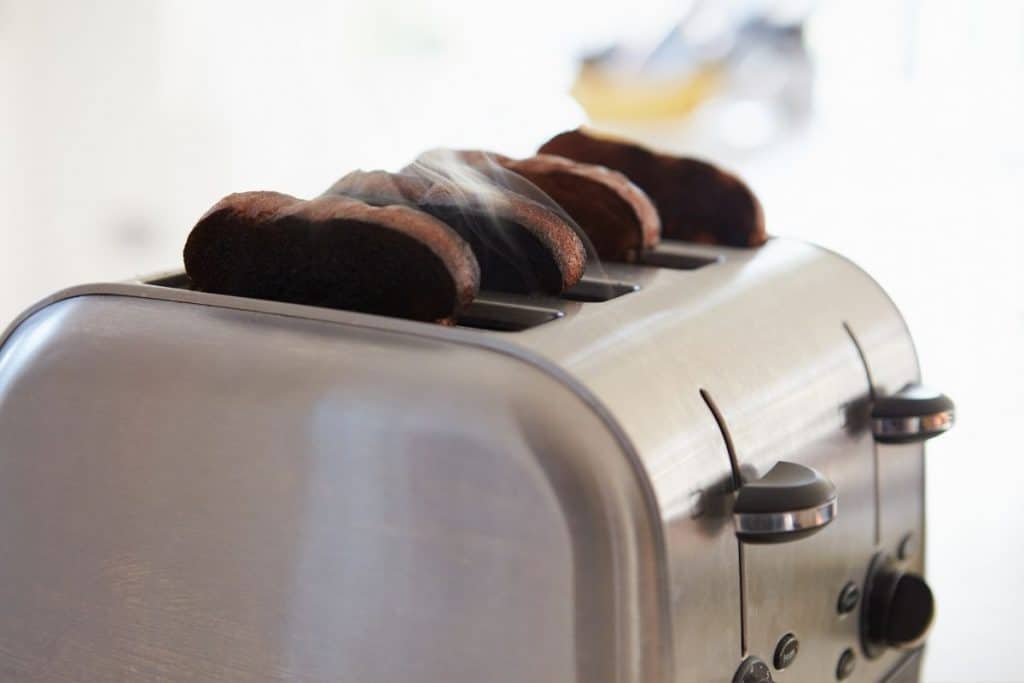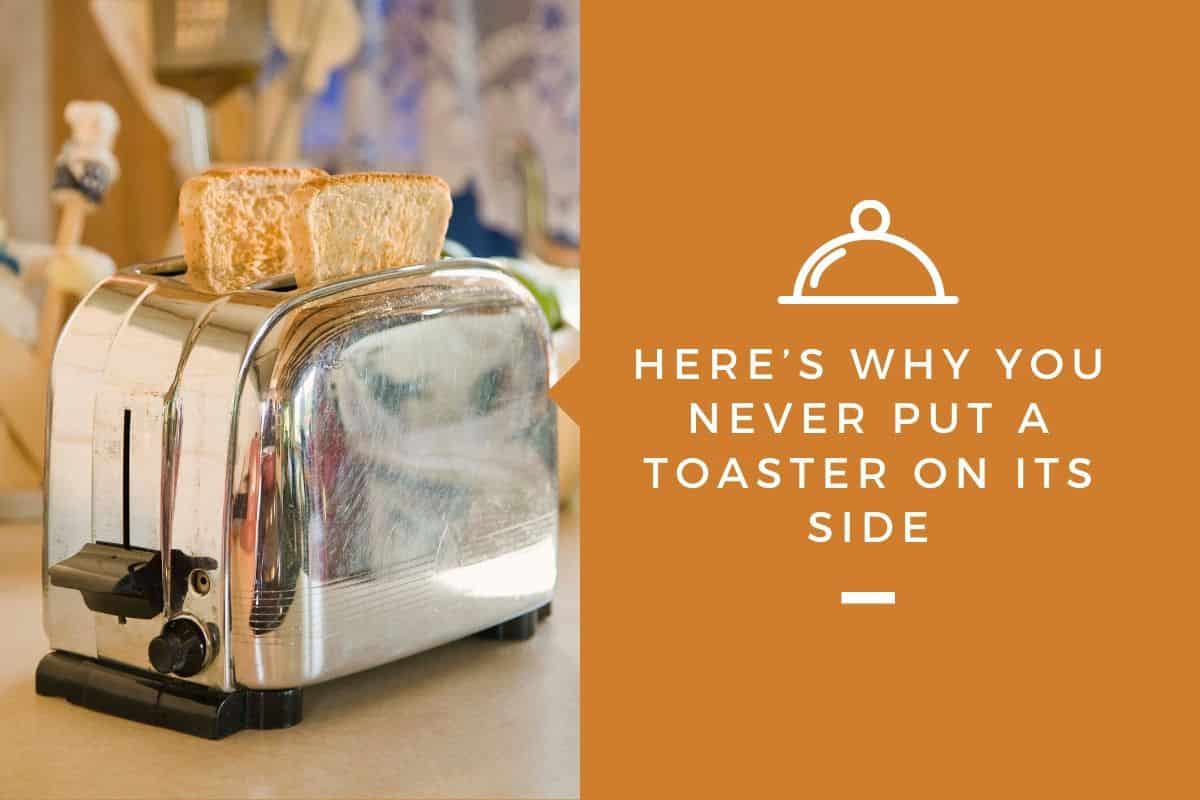Despite what you may have seen on a YouTube video or a TV show or read on the internet, laying a toaster on its side to make cheese toast or any other exotic snack that may come to mind is not only unwise, it is dangerous. Using a slot toaster for any purpose other than making toast is an open invitation to disaster.
Here’s why you never put a toaster on its side. A toaster shouldn’t be placed on its side because:
- The instructions included with the toaster say don’t.
- You may void the warranty.
- An electrical short could occur.
- The safety mechanisms may not work
- A fire could result for several reasons.
Putting aside the argument that what’s his name did it on YouTube, the most practical reason of all not to put a toaster on its side to make cheese toast is obvious.
The toaster wasn’t designed to work that way! Using a toaster any other way can create problems most people don’t take the time to consider. If you stop and think just a minute, some of those reasons become obvious.
The ins and Outs of Toasters
Yes, it’s a pun. What is really going on when you put your favorite bread product in the slot on top of the toaster and push down the lever?
- One the lever is pressed, the bread is lowered into the toaster, and a switch is depressed, allowing electricity to flow through the heating elements, usually wires made of nichrome.
- The heating elements give off radiant heat that begins to warm the bread, creating that nice brown toasted effect.
- A release mechanism is also being heated. At a predetermined temperature, the release mechanism that holds the bread down inside the toaster is opened, and the spring lever pops the toast back up through the slots.
- Voila! You have toast for your butter and jam.
What else is going on?
There are other things happening inside the toaster at the same time.
- As the heating elements heat the bread, it is also heating up all the other parts of the toaster. This can make the exterior sides of the toaster become hot enough to be painful to touch.
- The electricity is flowing through the nichrome wire. The wire is held away from any other part of the toaster by ceramic insulators that keep the electricity where it is supposed to be.
- As the toast darkens, small bits of the bread material tends to fall off. These crumbs end up in a tray at the bottom of the toaster, where they can be safely removed when the toaster has cooled.
- Several mechanisms and sensors are constantly monitoring the temperature of the toaster to make sure that an overheating situation doesn’t occur.
So, What’s the Problem with Laying a Toaster on its Side?

Let’s go back to the very beginning. When you opened the box and removed your new toaster, there were some other things in the box besides the protective packaging. One of those things was the user manual provided by the manufacturer.
On the first few pages of that booklet were some instructions on using your new toaster. In every user manual we checked, there was some statement like this one.
Do not use this toaster for other than its intended use.
A little common sense should tell you that laying a toaster on its side is not generally considered an ‘intended use.’ Which leads us to the question of:
What Could Possibly Go Wrong?
Several possible problems and hazards result from laying a pop-up slot toaster on its side and using it in that position.
- An electrical short could occur – Your toaster was designed to stand upright. The heating elements and their ceramic insulators were designed to be used in that position. Laying the toaster could cause the heating elements to sag and come into contact with other metal parts of the toaster. The result could be as bad as a fire.
- The safety mechanisms may not work. – Toasters depend on spring systems and sensors to release the spring lever and turn off the heating element. Some toasters have overheat sensors to keep them from getting too hot. These sensors may not work properly with the toaster on its side and the heating element can reach dangerous temperatures rapidly.
- The heat from the toaster can damage the countertop – The heating elements aren’t the only thing getting hot. The sides of many toasters also get hot. They can get hot enough to damage the countertop. The heat build-up without the airflow around the side of the toaster can build up to the point that a fire occurs.
- The Fire Danger – Breadcrumbs can fall directly onto the heating elements and catch fire. IF the heating elements overheat and are too close to plastic parts, the plastic parts may melt or catch fire.
The Answer Should Pop Out at You
The best reason I can think of to not lay a toaster on its side is that it is not what the toaster was designed to do. Let’s recap.
- The manufacturer specifically instructs you not to use the toaster for other than the intended use, which is to make toast and nothing but toast.
- The safety devices and other mechanisms on the toaster may not work as they were designed posing potential hazards.
- You can endanger yourself and your home.
There are better alternatives for making cheese toast than using a pop-up toaster on its side.
The Art of Toasting
No, we aren’t taking a side-track to drinking. We are talking about toasting your bread, making cheese toast, or any of several different things that might tempt you to lay that pop-up toaster on its side.
- Countertop Toaster Ovens – Using an appliance that was designed specifically to do the job you want is always a better option. Countertop toaster overs are designed so that you can safely toast your bread or make cheese toast without the hazards of laying a pop-up toaster on its side.
- Sandwich Makers – Several manufacturers make countertop sandwich makers that are designed to toast the bread on a sandwich. These appliances are much better options for toasting cheese sandwiches that a pop-up toaster on its side.
- Your cookstove and a pan – You can always do it the way your mother or your grandmother made your cheese toast. Use a pan and the cookstove in the kitchen.
But HE Did it!
Yes. HE did it. And HE got away with it. Which doesn’t mean you should do it or that you will get away with it.
What is more important, cheese toast or your safety and the health and wellbeing of your home and family? There are reports of the disastrous results that laying a toaster on its side and using it can have.
One homeowner in London, England, learned this lesson the hard way. After taking the advice of a well known TV chef, the homeowner prompty tried the toaster on its side.
Just as promptly, the homeowner was calling the fire brigade from the garden as their house blazed away. Sometimes life hacks are just that, hacks.
Black or Brown
Whether you like your cheese toast a golden brown or near the charred darker side, the fact remains that you shouldn’t lay that pop-up toaster on its side to create that culinary delight.
There are better ways and better appliances for making your delectable creation. Please save yourself the possible damage or injury and keep that toaster upright.

